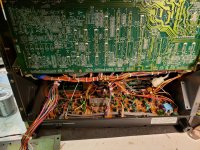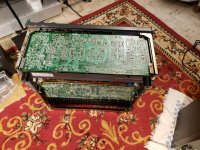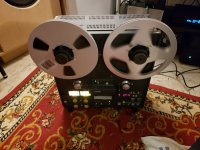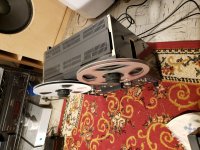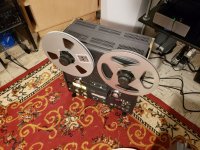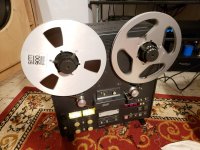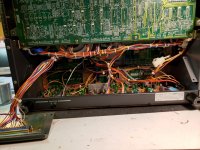Well, at 3-5 KΩ source Z, it's pretty much a dead heat between bipolar and FET in terms of noise performance. I agree that the NJM2043 is mediocre; I calculate the voltage noise density as ~14nV√Hz from the 2043 data sheet graph showing 2 µV @ 1KHz; so I think there's a lot of room for improvement. Both the 4562 and the 2134 are ~ 3 times faster. Both probably have an order of magnitude less THD than the 2043 as well (hard to tell on NJM devices, as they don't quote that spec, prolly for good reason). Due to TI's recent price drop, however, the LM4562 is about 1/3rd the price of the OPA2134. BTW, I'm sticking with DIP devices here!
Last edited:
Sort of my feeling as well wrt source impedance. The Otari uses a selected NJM2043D which I failed to note. My NJR data sheet indicates a typical noise of 0.4uV relative to 1kHz bandwidth using the JIS A test method. (They list other methods in the graph which are 6dB+ worse.)
They list an OLG of 100dB which is also mediocre by current standards, and I believe they actually have a class B output stage.
The really big concern is this deck has +/-20V rails and a lot of modern op-amps aren't too happy at elevated voltages. The MX-50N uses a tracking regulator and I could reduce the supply voltage +/-17V were I to decide use something like the LM4562. I know there are some good audio op-amps that are OK at +/-22V max just need to remember which.
They list an OLG of 100dB which is also mediocre by current standards, and I believe they actually have a class B output stage.
The really big concern is this deck has +/-20V rails and a lot of modern op-amps aren't too happy at elevated voltages. The MX-50N uses a tracking regulator and I could reduce the supply voltage +/-17V were I to decide use something like the LM4562. I know there are some good audio op-amps that are OK at +/-22V max just need to remember which.
Attachments
Well I finished putting the MX-50N (the one from NJ that got wet) back together tonight, and it's running.
The transport in this thing is in quite another league from the MX-5050, I'm quite surprised, and the overhaul improved its performance considerably despite the 95% electrical orientation of the work I did.
Every electrolytic in the unit has been replaced. I cleaned the boards scrupulously as I went. Cleaned the brake bands and friction materials, lubricated the capstan motor, and fixed a lot of corrosion damage.
Unfortunately the original reel tables and holders are trashed, not sure yet what to do. I am running MX-5050 tables and holders with shims (~10 mil tape) between the tables and holders which just allows me to adjust table height to spec.
It runs better at this point than the pretty MX-50N II, and unlike that deck everything now seems to be working on this one. (I have not yet attempted to record, but it does go into record)
I need to purchase calibration tapes at this point. Both of the MX-50Ns will need to be more accurately calibrated for IEC playback and record - this because the EQ is really only optimized for NAB or IEC and I have no idea which it was originally on either of these machines. I only use IEC @ 7.5 ips and 15 ips so those are the tapes I will purchase.
The transport in this thing is in quite another league from the MX-5050, I'm quite surprised, and the overhaul improved its performance considerably despite the 95% electrical orientation of the work I did.
Every electrolytic in the unit has been replaced. I cleaned the boards scrupulously as I went. Cleaned the brake bands and friction materials, lubricated the capstan motor, and fixed a lot of corrosion damage.
Unfortunately the original reel tables and holders are trashed, not sure yet what to do. I am running MX-5050 tables and holders with shims (~10 mil tape) between the tables and holders which just allows me to adjust table height to spec.
It runs better at this point than the pretty MX-50N II, and unlike that deck everything now seems to be working on this one. (I have not yet attempted to record, but it does go into record)
I need to purchase calibration tapes at this point. Both of the MX-50Ns will need to be more accurately calibrated for IEC playback and record - this because the EQ is really only optimized for NAB or IEC and I have no idea which it was originally on either of these machines. I only use IEC @ 7.5 ips and 15 ips so those are the tapes I will purchase.
Attachments
Thanks for the tip----looks like mine is a MKIII-8 from 1982. Now, are you saying that is one of the "good" transports?You can identify what year your machine was made by looking at the 2nd and 3rd digit in the serial #. I assume it is a MKIII-8 or MKIV-8? Or is it an earlier model? Interesting machines.
From a cursory look at the schematics, power appears to be +/- 15 volts (haven't actually measured it yet). But the repro head first IC is a Harris HA12017 in a SP-7 package (is that the same footprint as an SIL-8??); so replacement will be a little trickier than I had anticipated. These may be a little quieter than the NJM chips, but I don't suppose it will rival an LM4562; and the Harris quoted THD is -94db,compared to the 4562's -130db.(don't know if that is an audible difference). Subsequent ICs are NJM 4559s (a wider-bandwidth 4558). In my tables, I show the RC4558s to be on the order of 8nv/√Hz, and the current noise about double the 4562's. So there may very well be an audible difference in noise performance; though I'm not sure if this doesn't get buried in tape noise anyway.
Last edited:
So, after getting out my old Otari manual and perusing the specs (which I hadn't done for some time), I had to laugh at myself---we're talkin' good old TAPE here!! THD @ operating level is 0.5%; signal-to-noise ratio is 66 db (actually quite good for those days!) referred to +9 db over operating level---meaning 57 db below nominal signal level. Those old opamps are well below both those figures, so putting in new modern ones probably won't make a tinkers dam worth of difference!!
>Harris HA12017 in a SP-7 package (is that the same footprint as an SIL-8??)
I think that's the Hitachi HA12017 which is SIL-8 with a missing pin.
It was intended for low noise RIAA preamps. I still use a pair in an old preamp I built in the 80's. Pretty quiet but very mediocre PSRR.
I have the datasheet / RIAA appnote if you want it.
I think that's the Hitachi HA12017 which is SIL-8 with a missing pin.
It was intended for low noise RIAA preamps. I still use a pair in an old preamp I built in the 80's. Pretty quiet but very mediocre PSRR.
I have the datasheet / RIAA appnote if you want it.
Yes, I believe you are correct---Hitachi, not Harris. Yes, I would like to see your datasheet---the only one I could find has unreadable graphs. Poor PSSR; no slew rate quoted. Actually that's one thing the old opamps are poor at---slew rate. The 4558 is 1v/ µsec; the 4559 is 2v/µsec. I don't know if it's important but Alistair Heaslet must have thought so when he designed the King of All Tape Recorders (the Ampex ATR-100), as he put in super fast (50v/µsec, though they slewed asymmetrically) LM318s. That may be a reason to upgrade the ICs in our aging machines.I think that's the Hitachi HA12017 which is SIL-8 with a missing pin. I have the datasheet / RIAA appnote if you want it.
The MKIII transport is fine with modern tape, but it's basic like the transport in my '88 MKIII. The MX-50 transport is more refined and a lot better with fragile vintage tape.
The dirty little secret about the 4558 is it's basically a dual 741 gleaned from my days at a large audio manufacturer.
The op-amp comment is a valid one which is why I have not rushed into replacement so far, there may be some benefit even so..
The dirty little secret about the 4558 is it's basically a dual 741 gleaned from my days at a large audio manufacturer.
The op-amp comment is a valid one which is why I have not rushed into replacement so far, there may be some benefit even so..
Hi Kevin,
Yes, the 4558 is closer to the LM741 than anyone would like to admit to. It's also a little noisy. I yank them unless they are performing a housekeeping function, but they go when involved with audio in any way. That includes DC servos.
Beside a 4558, a TL072 sounds good.
-Chris
Yes, the 4558 is closer to the LM741 than anyone would like to admit to. It's also a little noisy. I yank them unless they are performing a housekeeping function, but they go when involved with audio in any way. That includes DC servos.
Beside a 4558, a TL072 sounds good.
-Chris
How so? Does it have DC servo-controlled reel motors?The MX-50 transport is more refined and a lot better with fragile vintage tape.
Several people told me this around the time I purchased the first deck and I was skeptical. I can report from observation that tape handling in the MX-50 is a lot smoother than the MX-5050. (Most noticeable on starts, stops and direct transitions from one mode to another.)
There are pretty significant differences in the electrical design of the deck's logic electronics. IIRC the BII/MKIII rely heavily on state machines implemented in logic and the 50N is microprocessor controlled with triacs and just a single relay per reel motor.
This is all anecdotal/empirical as I have no means yet to measure torque or tape tension.
There are pretty significant differences in the electrical design of the deck's logic electronics. IIRC the BII/MKIII rely heavily on state machines implemented in logic and the 50N is microprocessor controlled with triacs and just a single relay per reel motor.
This is all anecdotal/empirical as I have no means yet to measure torque or tape tension.
Hi Kevin,
-Chris
Not really. You just can't put numbers on it. I wonder, if you use a DSO on a slow time constant, might you see a ramped power up for the reel motors and possibly the capstan? The same study would show the 5050 just goes "bang" on and "bang" off.This is all anecdotal/empirical as I have no means yet to measure torque or tape tension.
-Chris
THAT HAVING BEEN SAID, I hate the thought of 741-ish opamps in any piece of my audio gear! So, since TI has lowered the price of LM4562s to a ridiculously low price (just over a buck in larger quantities), I'm gonna put 'em in my Otari anyway! Now, as for those nearly 40 year-old caps, those gotta go too. I am considering polyester for the coupling caps over electrolytics; poly pros would be too big at 10 to 33 µF..........we're talkin' good old TAPE here!! THD @ operating level is 0.5%; signal-to-noise ratio is 66 db (actually quite good for those days!) referred to +9 db over operating level---meaning 57 db below nominal signal level. Those old opamps are well below both those figures, so putting in new modern ones probably won't make a tinkers dam worth of difference!!
Good thought! I am probably going to be trailing behind a bit as I need to finish a project for a friend. I would like to hear how it goes, impressions, measurements if you would like to share.
I am not sure what those capacitors are, but I was thinking that at least in the playback pre-amp that some good polystyrenes might be a nice upgrade. (I'm thinking RTE from REL)
I am not sure what those capacitors are, but I was thinking that at least in the playback pre-amp that some good polystyrenes might be a nice upgrade. (I'm thinking RTE from REL)
Nope. Just checked Mouser---film capacitors of 10-33µF are just TOO big and TOO expensive---have to stick with low-ESR electrolytics. There are ~10 coupling caps of 10 & 33µF in the audio path (repro & record) per channel, so..........polystyrene also out of the question for large values......Now, as for those nearly 40 year-old caps, those gotta go too. I am considering polyester for the coupling caps over electrolytics; poly pros would be too big at 10 to 33 µF.
Nope. Just checked Mouser---film capacitors of 10-33µF are just TOO big and TOO expensive---have to stick with low-ESR electrolytics. There are ~10 coupling caps of 10 & 33µF in the audio path (repro & record) per channel, so..........polystyrene also out of the question for large values.
May I suggest BiPolar caps.
According to some research done years ago BP caps were a very good choice for coupling of stages in audio circuits. Even back to back Elcos were not bad, but occupy more space.
Unfortunately cannot find the link now, but it must be still out there somewhere.
Black Gates are great, but too pricey.
And good quality BPs can be found easily.
Almost all coupling caps in Otari decks are BP (bi-polar aka non-polar types). They are also widely used in the electronic switching decoupling circuits which until very late in the product life was all done with discrete N and P jfets.
I use Nichicon Muse in the audio path and somewhat less expensive Nichicon BP types in the switching circuits. The MX-55 appears to have come with Nichicon Muse in the audio path by default. (I have only looked at a couple)
I did not purchase the MX-55D I was recently offered because I can't fit another meter bridge equipped recorder into my space, had it been an N it would be here now.
I use Nichicon Muse in the audio path and somewhat less expensive Nichicon BP types in the switching circuits. The MX-55 appears to have come with Nichicon Muse in the audio path by default. (I have only looked at a couple)
I did not purchase the MX-55D I was recently offered because I can't fit another meter bridge equipped recorder into my space, had it been an N it would be here now.
Almost all coupling caps in Otari decks are BP (bi-polar aka non-polar types). They are also widely used in the electronic switching decoupling circuits which until very late in the product life was all done with discrete N and P jfets.
I use Nichicon Muse in the audio path and somewhat less expensive Nichicon BP types in the switching circuits. The MX-55 appears to have come with Nichicon Muse in the audio path by default. (I have only looked at a couple)
Thank you for the clarification, I didn't know that.
Assumed that like in many other circuits, e.g. Rotel integrated amps, the coupling caps are polarised electros.
- Home
- Source & Line
- Analogue Source
- So you think you want to play with tape: An Otari Story
